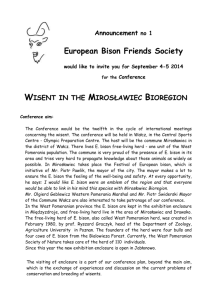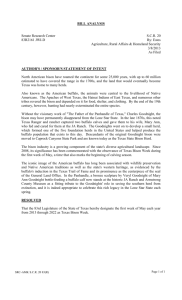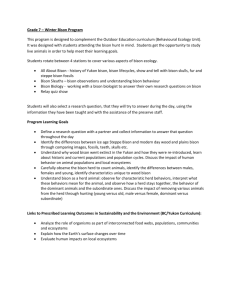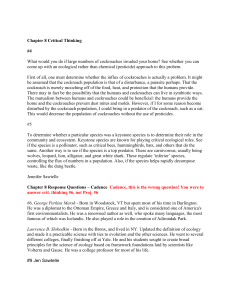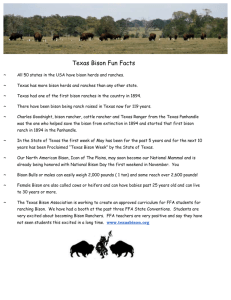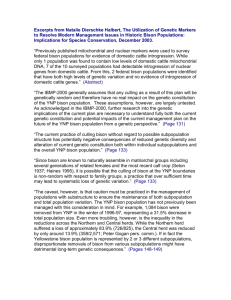1 Sturgeon River Plains Bison Management Plan Workshop
advertisement
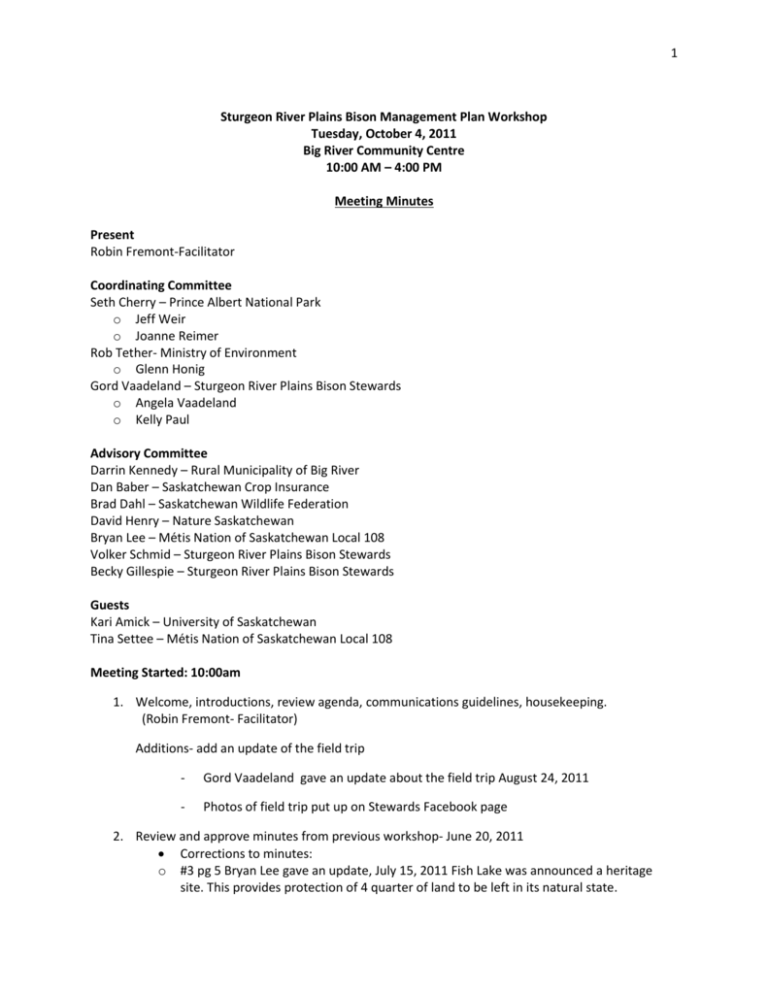
1 Sturgeon River Plains Bison Management Plan Workshop Tuesday, October 4, 2011 Big River Community Centre 10:00 AM – 4:00 PM Meeting Minutes Present Robin Fremont-Facilitator Coordinating Committee Seth Cherry – Prince Albert National Park o Jeff Weir o Joanne Reimer Rob Tether- Ministry of Environment o Glenn Honig Gord Vaadeland – Sturgeon River Plains Bison Stewards o Angela Vaadeland o Kelly Paul Advisory Committee Darrin Kennedy – Rural Municipality of Big River Dan Baber – Saskatchewan Crop Insurance Brad Dahl – Saskatchewan Wildlife Federation David Henry – Nature Saskatchewan Bryan Lee – Métis Nation of Saskatchewan Local 108 Volker Schmid – Sturgeon River Plains Bison Stewards Becky Gillespie – Sturgeon River Plains Bison Stewards Guests Kari Amick – University of Saskatchewan Tina Settee – Métis Nation of Saskatchewan Local 108 Meeting Started: 10:00am 1. Welcome, introductions, review agenda, communications guidelines, housekeeping. (Robin Fremont- Facilitator) Additions- add an update of the field trip - Gord Vaadeland gave an update about the field trip August 24, 2011 - Photos of field trip put up on Stewards Facebook page 2. Review and approve minutes from previous workshop- June 20, 2011 Corrections to minutes: o #3 pg 5 Bryan Lee gave an update, July 15, 2011 Fish Lake was announced a heritage site. This provides protection of 4 quarter of land to be left in its natural state. 2 3. Update on management plan writing (Coordinating Committee Rob Tether and Seth Cherry) Feedback on background sections and disease chapter: o Section 2, one group that should be added is local municipalities because provincially they have some management roles in their communities. Be more specific then local community it should be local RM, town council, etc. o In actions certain groups should be identified in the actions, for example who are the leads of the action, who is responsible. o Missing from the draft is the issue of harvest. Is there going to be an action to slow down the harvest? Response: We will be discussing this issue today so that is why it is not in the draft plan yet. It will be added to the plan once we have our discussion today. o Should be stated in the plan what allocation ladder will be followed for the harvest issue. Discussion on proposed format for plan: o I think the format of the plan is fairly easy to read, has a good flow, and is easy to understand. o Under section 5 I would like to see a 5.4 about current status of diseases in the population. o Should acknowledge the historic and cultural role bison have but I would like to see interpretive potential. And I would like to see how bison’s role in the ecosystem is important. o Order of topics need to be considered. Perhaps should have disease section latter in the plan, maybe have population demographics first and goal for population number. o Before disease section we should have our population goals. Take some time during the breaks today and after the meeting to identify any other issues you have with the plan and we will have discussions at the next meeting. Please send your comments to Angela via email, or you can call Seth Cherry at 306-663-4542. 4. Presentations: Managing Population Demographics for Long Term Conservation- Seeking Balance (Seth Cherry, Prince Albert National Park) [PDF file of this presentation placed on the Bison Stewards web site] Questions/Comments/Responses 1. Stewards have not noticed a difference in human bison conflicts since the population was above 400 until now with the population being half. 2. If this herd decreases any more is there a chance we could bring in more bison from Elk Island National Park? Response: It is a possibility but only for genetic purposes, for example if we brought a couple new bulls in to add to genetics. We would not bring in a large 3 3. 4. 5. 6. o number of animals to replenish the herd because this would cause an up roar with locals and we would be failing or goal of conservation of this particular herd. (Seth Cherry, PANP) Provincially most translocations have been stopped because of disease. It could be possible from federal land to federal land but provincially we have stopped. We need to address this in the plan to stop the misperception that if the bison population drops to X amount of animal’s managers will bring in more. (Rob Tether, MOE) Out of the 3 items affecting this bison herd (disease, predation, hunting) we can only control hunting. We need a procedure to put limitations on harvesting from First Nations. Are bison on the endangered species list? Response: They are listed as Threatened by COSEWIC but they are not listed as a species at risk by SARA because ranched domestic bison would be affected by the designation. Also, some provinces do not consider bison wildlife they consider them livestock. Could someone talk about the First Nations hunting legislation? Response: There is no hunting in the Park. (Seth Cherry, PANP). Provincially First Nations have the right to hunt wildlife for sustenance on unoccupied crown land, crown forest and private land with permission (right of access). Landowners can specify conditions for First Nations hunting on their land, for example, timelines, certain species, and limited numbers of animals allowed to harvest, etc. There is a hierarchy of use of species. If species reaches a threshold for conservation the species will be fully protected and no one will be able to hunt. If the province reviewed this bison herd situation and given enough evidence that they need conservation MOE could restrict all uses of this species. But you need scientific evidence that the species needs conservation. If there is a high enough population sustenance hunters and potentially selected provincial residents could hunt the species. (Rob Tether, MOE) Certain Métis Nations are allowed to hunt in designated areas of their land so we need to know about this when talking about harvesting these bison. Seth updated advisory group about the information package sent out to First Nations and other local communities about the current status of the Sturgeon River Plains Bison Herd. 7. The blood samples at the University of Alberta will determine genetic variability of this population? Response: Yes Greg Wilson will help us determine genetic variability and if any cattle gene introgression is present in the herd. If the genetic variability is low we will need to determine what we need to do to increase it. This is the only possibility where we might want to bring in some animals to increase the genetic diversity. (Seth Cherry, PANP) 8. Interactions of bison and other species in park should be looked at. Elk Island National Park has researched this and it should be looked at to see if there are any negative impacts we should be aware of. A literature review should be done for this management plan. Response: Prince Albert National Park does not have any scientific research on this nor is there any issues known of, but Parks does an annual State of Park Report (SOP) which we could look at. There might not be any issues yet because our population has not reached high enough numbers, although we should look into it. Also, U of Laval is looking at wolf predation on the bison and how it might change over time, and how predation effects land selection by bison. Do we want a literature review in the plan or updates of the SOP from the Park sighted in the plan? (Seth Cherry, PANP)Response: There is a lot of literature out there that native bison have influenced ecology positively. It is generally accepted that bison present in historic bison areas are positive. We are on fringe of Plains range so we might be 4 ok. Maybe we should identify research priorities as a part of the plan. Maybe list some areas we want more information on because there is not much information in some areas, for example predation of bison by wolves. With this list some researchers could maybe work on this in the future because we will probably not have time to do this due to other priorities of the plan. Lunch Break 5. Summary of points from discussion regarding three questions given by Seth Cherry to Advisory Committee What is the best way to determine minimum population threshold for conservation purposes? -Use recommended numbers from Elk Island National Park and our own research. Therefore for genetic purposes 175-250 animals might be a suitable minimum threshold. -Genetic diversity needs to be addressed to help establish threshold number. - What buffer is required to address disease and predation? Allow genetic research from the Park’s dna samples to determine minimum threshold then determine buffer. -How is a buffer established? It could be based on history of the herds decline. It only took 3 years for the herd to decrease by half. A percentage could be found to address disease and predation. - An interim buffer should be 450 subject to research. - 450 exceed the maximum social carry capacity. - Numbers can be placed in management document at a later date. -May need field research to determine actual herd numbers. Aerial surveys may not provide exact numbers. - Potential action item- need to get the social carry capacity to increase and need to include landowners and First Nations in this process. How do we ensure numbers do not decline below this threshold? - Need a specific action plan implemented if numbers drop below threshold. If numbers get below a certain threshold specified action plans should be looked at with individual landowners, Parks Canada’s wolf research for predation, and MOE regulating harvest. -Explore options to deal with disease, predation and harvest. 5 -Could control harvest through agreement on overall management plan. - Put this back into the hands of MOE to deal with the problem and help with some action. -Interim recommendation to the province that the bison herd is now at risk. Try to have the bison added to the Saskatchewan endangered species list. -Education involving landowners and First Nations to work towards an interim agreement. When is increased management required to ensure social carry capacity is not exceeded? - Specific numbers of bison, conflicts or both? - What management actions could be used? -The problem is the amount of bison leaving the park and going onto private land. It is nice to see a couple bison on my land but not 120 or more of them, the crop damage is frustrating but not as much as the fence damage. When the bison start coming onto private land it is during harvest season and landowners don’t have time to be running to fix fence. – Try to solve tolerance level by compensating landowners, address crop loss and fencing. Maybe fence crews should be established through compensation. -Ensure that there is adequate habitat. Does the park have any plans to burn inside the park to increase bison habitat? I was at a conference in Oklahoma and they manage their bison habitat and bison movement with burning their grass lands. Response: Yes the park has implemented a burning plan that will burn areas to increase bison habitat. Some areas have been burned already but will take a couple more burns over the next few years to be complete. There are other areas that will be burned in the near future as well to continue increasing habitat. -Private shareholder agreements that allows for revenue sharing might increase tolerance. - Increase tolerance through education, get youth involved for early buy in for this process, and to become aware of solution options. - Should have an action item for MOE and Parks to be more involved with conversation with the landowners and First Nations. 6. Plan for the Next Workshop Topic : Managing Human/Bison Interactions Date: December 6, 2011 Time: 10:00 AM 6 Location: Big River Community Centre 7. Closing Comments Next meeting decide how to solve the issue that a conservation threshold number is 450 which is higher than the maximum social carry capacity. Park personnel will talk about current bison management and discuss what could be done in the future at the next meeting. MOE and SCIS representatives hope to bring two people higher in the agencies next meeting to talk about different solutions from various programs and have them ready to have discussions with the group for what is available and what could be possible. Bison Stewards to present work to date on items pursuant to damage prevention (hazing, fencing, etc.) How do we involve First Nations? Maybe we need to go to the First Nations communities to meet with them about the plan, different issues affecting the bison herd and maybe get them more involved. Suggestion from Glenn Honig, MOE: go to the band themselves otherwise the message does not reach the people that should to be reached. Providing the background information about the herd and plan would be important at these meetings to help avoid too much back tracking at the next workshop. Try to have some landowners attend next meeting. Meeting ended- 3:45 PM


